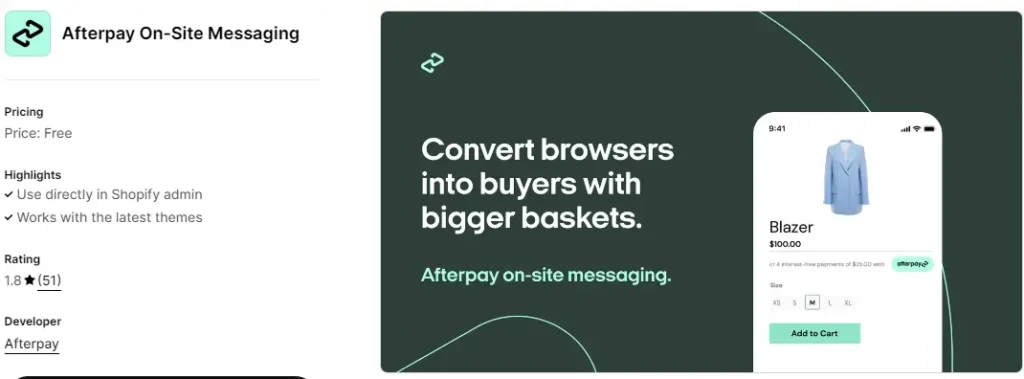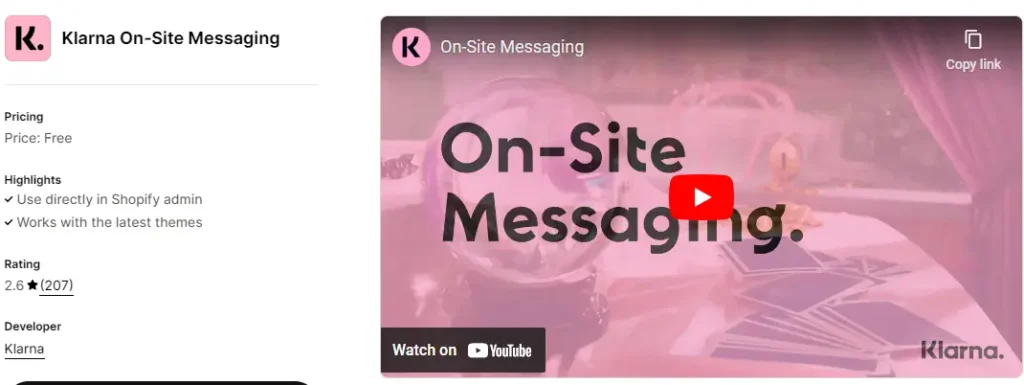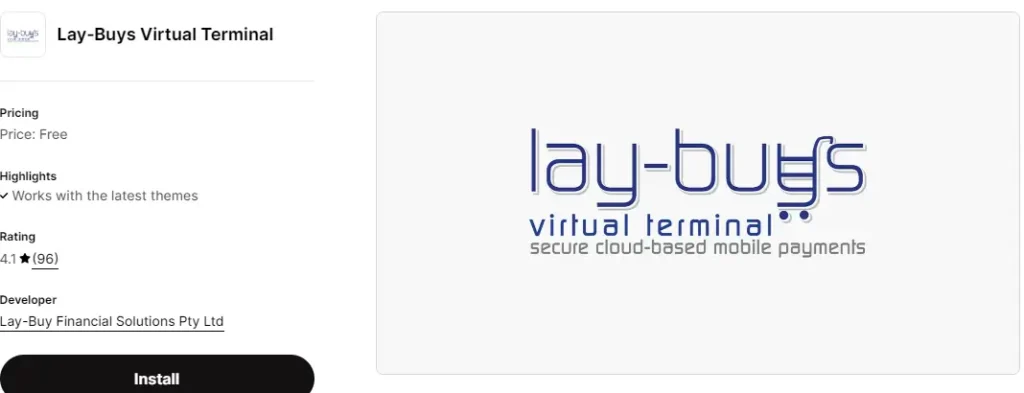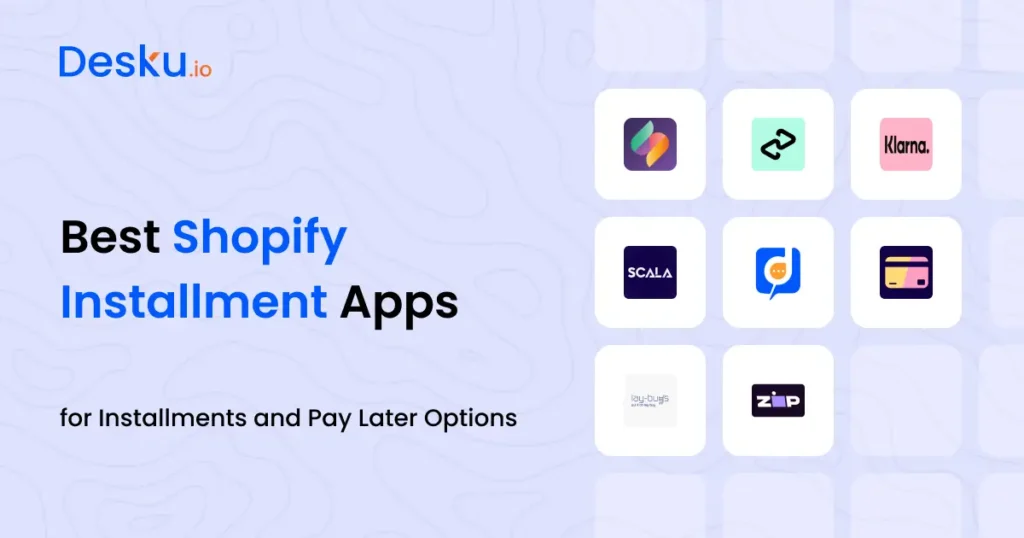Offering installment payments can make a big difference in your Shopify store’s sales. The option to split payments over time helps customers afford larger purchases, leading to more conversions and higher average order values. In fact, many ecommerce brands that introduced installment plans have seen significant drops in cart abandonment.
If you’ve been thinking about offering flexible payment options, Shopify installment apps are the easiest way to get started. From boosting sales to improving the customer experience, these apps allow your buyers to spread payments over time without worrying about credit or high-interest rates.
In this article, we’ll cover the 5 best Shopify installment apps for ecommerce stores in 2024, each with different features, pricing, and benefits that can help you find the best fit for your business.
Shopify powers over 4.8 million active websites globally.( Source )
What Are Shopify Installment Apps and Why Use Them?
Shopify installment apps are third-party tools that allow customers to break up the cost of their purchases into smaller, manageable payments over a set period of time. Instead of paying the full amount upfront, buyers can choose to pay in installments, making larger purchases more affordable.
Why should you offer installment options on your Shopify store?
- Increase Conversions: Many customers abandon their cart when faced with a large one-time payment. Installment plans reduce that friction by spreading the cost, which encourages shoppers to complete their purchase.
- Boost Average Order Value (AOV): When customers know they can split payments, they tend to spend more. Offering installments can lead to bigger baskets, meaning higher revenue for your store.
- Attract New Customers: Flexible payment plans can be a huge selling point for first-time visitors. Offering this option can set your store apart from competitors who don’t provide installment options.
- Improve Customer Loyalty: Customers appreciate the flexibility of installments, which leads to better overall satisfaction. When customers have a smooth shopping experience, they’re more likely to return for future purchases.
How to Choose the Right Installment App for Your Store
Choosing the right Shopify installment app depends on your store’s needs, your customer base, and how much flexibility you want to offer. Here are some key factors to consider when selecting an app:
1. Transaction Fees
Each app has its own fee structure, which could include a percentage of the transaction or flat fees. Some apps charge fees to the store owner, while others may pass the cost to customers in the form of interest or processing fees. It’s important to understand how these fees will impact your profit margins. If you want to keep things simple, Shopify’s native Shop Pay Installments has no extra fees for stores already using Shopify Payments.
2. Integration with Shopify
Some apps offer seamless integration, while others might require a bit more manual setup. Look for apps that are built to work specifically with Shopify’s checkout process to avoid potential hiccups. Shopify-specific apps like Shop Pay Installments or Sezzle tend to be easier to implement without any coding knowledge.
3. Customer Experience
The payment process should be as smooth and straightforward as possible. Make sure the app provides a clean user interface for your customers and doesn’t disrupt their shopping experience. A clunky checkout can lead to abandoned carts, which defeats the purpose of offering installment payments in the first place. Klarna and Afterpay are known for their user-friendly experiences and ease of use.
4. Customer Support
If something goes wrong, you’ll need reliable support. Check whether the app provides solid customer support, especially during setup. It’s also good to know if there’s ongoing help available in case you or your customers face any issues later on. Partial.ly offers good customer service and onboarding help if you’re new to installment apps.
5. Security and Fraud Protection
Payment security is a major concern for both customers and store owners. Make sure the app you choose follows industry-standard security measures, like encryption and fraud detection. Klarna and Afterpay both have strong security protocols, so they are trusted by major ecommerce brands globally.
6. Global or Local Reach
Depending on your audience, you’ll want to choose an app that works well in your target region. Some apps, like Afterpay and Klarna, have a strong presence in international markets, making them a good choice for stores with a global customer base. Others, like Shop Pay, may be more suited for local or US-based stores.
Read More:Top 6 Shopify Apps for Product Comparison
5 Best Shopify Installment Apps for 2024
Here’s a detailed look at the top installment apps for Shopify, including their features, pricing, and pros and cons to help you decide which one fits your store best.
1. Sezzle

- Features: Sezzle allows customers to split their payments into four interest-free installments over six weeks. It integrates smoothly with Shopify, letting customers see the installment option directly at checkout.
- Pricing: No upfront costs. Merchants pay transaction fees starting at 6%, plus 30¢ per transaction.
- Pros:
- Interest-free for customers.
- No impact on credit scores for users.
- Quick and easy setup for Shopify stores.
- Cons:
- Transaction fees for merchants can be high.
- Customer base may be limited to regions where Sezzle is popular (US, Canada).
- Rating:(4.5/5)
Read More:10 Best Shopify Product Display Apps
2. Afterpay

- Features: Afterpay offers a “Pay in 4” model, allowing customers to pay for their purchase in four installments, with payments due every two weeks. It’s well-known and trusted by shoppers.
- Pricing: Merchant fees typically range from 4-6%, depending on the plan.
- Pros:
- Huge global presence, especially in Australia, New Zealand, and the US.
- No interest charged to customers, which is a big selling point.
- Trusted by many large ecommerce brands.
- Cons:
- Higher fees for merchants compared to some other apps.
- Limited customization of payment plans.
- Rating:(4.6/5)
3. Klarna

- Features: Klarna offers flexible payment options including “Pay Later” and “Pay Over Time” (ranging from 30 days to several months). Customers can pay in 4 installments or finance their purchases.
- Pricing: Merchant fees are based on transaction value but typically range between 3-7%.
- Pros:
- Klarna’s multiple payment options cater to a wider customer base.
- Strong international presence in Europe, the US, and Australia.
- High level of trust among customers.
- Cons:
- Some merchants find the fee structure complex.
- Not available in every country, so it may not work for all global stores.
- Rating:(4.7/5)
Read More:9 Best Product Options Apps – Shopify App Store
4. Splitit

- Features: Splitit allows customers to pay in installments using their existing credit card limit. It doesn’t charge interest or require credit checks, and there are no late fees.
- Pricing: Merchant fees start at 1.5% per transaction, depending on the plan.
- Pros:
- No interest or fees for customers.
- Works with any credit card, making it globally accessible.
- Customers don’t need a new credit account to use it.
- Cons:
- Higher merchant fees than some other installment apps.
- Requires customers to have available credit on their card, limiting accessibility for some users.
- Rating:(4.3/5)
5. Lay-Buy

- Features: Lay-Buy operates on a layaway model where customers make a down payment and then complete payments over time. The store fulfills the order after the final payment is made.
- Pricing: 1.9% per transaction, with no additional monthly fees.
- Pros:
- Low transaction fees for merchants.
- Allows merchants to control fulfillment until full payment is made.
- Easy to set up within Shopify.
- Cons:
- Longer fulfillment times could lead to lower customer satisfaction.
- Customers have to wait for their product, which can lead to lower conversions.
- Rating:(3.8/5)
Read More: Top 9 Shopify Custom Product Variant Apps
Comparing the Top Features of These Installment Apps
When it comes to choosing an installment app for your Shopify store, it’s important to weigh the features that matter most to your business. Here’s a breakdown of the key features across the 8 apps we reviewed, so you can see how they stack up.
| App | Interest-Free for Customers | Customizable Payment Plans | Merchant Fees | Global Availability | Ease of Integration |
|---|---|---|---|---|---|
| Sezzle | Yes | No | 6% + 30¢ per transaction | US, Canada | Easy |
| Afterpay | Yes | No | 4-6% | US, Australia, New Zealand | Easy |
| Klarna | Yes (Pay Later) | Yes (Pay Over Time) | 3-7% | US, Europe, Australia | Easy |
| Shop Pay | Yes | No | No additional fees with Shopify Payments | US only | Seamless |
| Splitit | Yes (via Credit Card) | No | Starts at 1.5% | Global | Moderate |
| Partial.ly | No | Yes | 5% or $8 minimum | Global | Moderate |
| Lay-Buy | No | Yes (Layaway model) | 1.9% per transaction | Global | Moderate |
| Quadpay | Yes | No | 4-6% | US | Easy |
1. Interest-Free for Customers
- If offering interest-free payments is a priority to improve conversions, apps like Sezzle, Afterpay, Klarna, and Quadpay are your best bets. These apps allow customers to split payments without paying extra, which can reduce cart abandonment.
2. Customizable Payment Plans
- If you need more flexibility, such as creating custom payment schedules or requiring down payments, Partial.ly and Lay-Buy are the apps to consider. Partial.ly even lets you adjust payment terms on a customer-by-customer basis.
3. Merchant Fees
- If low merchant fees are your main concern, Shop Pay offers a huge advantage if you’re already using Shopify Payments, as there are no extra transaction fees. On the other hand, Lay-Buy also has low fees, making it a great budget-friendly option for merchants.
- Splitit has the lowest starting fees at 1.5%, but this can vary based on your transaction volume. In contrast, Sezzle and Afterpay charge higher fees, ranging from 4-6%, but they’re popular with customers and well-trusted.
4. Global or Local Availability
- For businesses with a global reach, consider Klarna or Splitit, which have a presence in Europe, the US, and Australia. Afterpay is great for the US, Australia, and New Zealand markets. Sezzle works well for US and Canadian audiences.
- Shop Pay is currently limited to US merchants and customers, which could be a downside for stores targeting international markets.
5. Ease of Integration
- If you’re looking for a hassle-free setup, Shop Pay is the easiest, as it’s natively integrated with Shopify. Sezzle, Afterpay, and Quadpay also offer very smooth integration processes.
- Apps like Splitit, Partial.ly, and Lay-Buy may require a bit more manual setup, but they provide additional flexibility in how payment plans are structured.
Read More:8 Best Shopify Purchase Options Apps for Customization and Subscriptions
How Offering Installment Payments Impacts Your Shopify Store’s Sales
Introducing installment payment options on your Shopify store can have a significant positive impact on your overall sales and customer experience. Here are a few key ways that these apps can help your business grow:
1. Increase Conversion Rates
Many customers hesitate when faced with a large one-time payment, leading to high cart abandonment rates. Offering installment payments reduces the psychological barrier of a big expense by breaking it down into manageable payments. This flexibility encourages customers to complete their purchase, which directly improves your conversion rate.
Fact: According to studies, offering “Buy Now, Pay Later” options can reduce cart abandonment by as much as 44%, especially for high-ticket items.
2. Boost Average Order Value (AOV)
Installment payment options make larger purchases more appealing to customers. When customers know they don’t have to pay the entire amount upfront, they are more likely to add extra items to their cart or opt for higher-priced products. This leads to an increase in your average order value (AOV), which is a key metric for growing revenue.
Example: A customer might hesitate to spend $300 on a product, but if they only need to pay $75 upfront and spread the rest over the next few weeks, they are more likely to make the purchase. This is why apps like Sezzle and Klarna are so popular for high-ticket products.
3. Attract More Customers
Offering installment payment options can set your store apart from competitors who do not offer flexible payments. Younger customers, especially Gen Z and Millennials, are increasingly relying on “Buy Now, Pay Later” solutions. If your target audience includes younger consumers, installment apps can help you attract and convert more visitors.
Stat: Approximately 60% of Gen Z shoppers have used a “Buy Now, Pay Later” option, with expectations for this number to keep growing.
4. Improve Customer Loyalty
Installment plans aren’t just great for attracting new customers; they can also boost loyalty from your existing customers. When people have a smooth and flexible payment experience, they’re more likely to return to your store for future purchases. Repeat business is crucial for building a sustainable ecommerce brand, and flexible payments can play a big part in keeping customers happy.
Tip: Promote your installment options prominently on your product pages, in your email marketing, and at checkout to remind customers of their payment flexibility.
5. Make High-Ticket Products More Accessible
If your store sells expensive items like electronics, luxury goods, or high-end fashion, offering installments can make these products more accessible to a broader audience. Customers are often hesitant to make large purchases, but installment apps lower the risk and pressure, allowing you to reach shoppers who might otherwise pass on the purchase.
Example: Luxury fashion retailers using Klarna have seen significant increases in sales because customers feel more comfortable buying premium items when they can pay over time.
6. Reduce Cart Abandonment
Payment friction is one of the biggest reasons for cart abandonment. Customers may reach the checkout and then leave due to the shock of a high upfront cost. Installment payment options help soften that shock and make the purchase feel more attainable. Offering options like Afterpay or Shop Pay Installments directly at checkout can reduce your store’s abandonment rates and increase final sales.
Fact: Payment flexibility options like those offered by Afterpay and Sezzle can reduce cart abandonment by up to 50%.
Tips for Managing Installment Payments Without Hurting Cash Flow
Offering installment payments can be a game-changer for your Shopify store, but it’s important to manage this new payment structure carefully so it doesn’t negatively impact your cash flow. Here are some tips to help you make the most of these apps while protecting your business from potential risks.
1. Choose an App with Guaranteed Payouts
Some installment apps offer guaranteed payouts to merchants, meaning you’ll receive the full payment upfront, even though the customer is paying over time. This protects your cash flow and ensures you’re not left waiting for funds. Apps like Sezzle, Klarna, and Shop Pay Installments often pay merchants the total purchase amount right away, while they handle collecting the remaining installments from the customer.
Pro Tip: If maintaining healthy cash flow is your top priority, always opt for apps that provide immediate payouts to merchants, even if they come with slightly higher fees.
2. Monitor Transaction Fees
Each app has its own fee structure, usually charging merchants a percentage of the transaction. While installment options can increase your average order value (AOV), you should still calculate how these fees will impact your profit margins. Make sure the higher transaction fees don’t eat too deeply into your profits.
Example: If you’re selling high-ticket items, the boost in sales could easily outweigh the cost of merchant fees. However, for lower-priced items, those fees could add up quickly, so you need to be cautious.
3. Set Minimum Order Values for Installments
Offering installments on every purchase might not be financially viable, especially for smaller orders where the merchant fees outweigh the benefits. Consider setting a minimum order value for which installment options become available. This ensures that the payment plan only applies to larger orders where the increased revenue justifies the fees.
Example: You could set a rule that installment plans are only available for orders over $100, ensuring that smaller purchases won’t negatively affect your margins.
4. Keep an Eye on Payment Defaults
While installment apps are responsible for collecting payments from customers, there’s always a risk that customers might default or miss payments. Some apps, like Partial.ly, allow merchants to set stricter payment terms, such as requiring a down payment or adding automatic reminders for missed payments. Make sure to choose apps that have strong fraud protection and risk management measures in place.
Pro Tip: If you choose an app like Lay-Buy, which uses a layaway model, you can hold off on fulfillment until the customer has paid the full amount. This guarantees you won’t lose money on an order due to payment defaults.
5. Balance Payment Flexibility with Profit Margins
While installment plans can boost sales, it’s important to find a balance between offering flexibility and protecting your profit margins. Some apps allow you to pass transaction fees onto customers, especially if they choose longer-term financing or custom payment schedules. Consider offering interest-free options for shorter payment plans, while charging small fees for longer-term financing.
Example: You could offer customers interest-free installments if they choose a 4-week payment plan but charge a small fee for 6-month financing to offset the risk.
6. Track and Analyze Sales Performance
Once you’ve implemented installment payments, track how they impact your overall sales performance. Tools like Google Analytics or Shopify’s analytics dashboard can help you monitor changes in conversion rates, cart abandonment, and average order value. Use this data to evaluate whether installment payments are driving enough revenue to justify the fees.
Pro Tip: Set up a tracking system to compare how your conversion rates and AOV perform before and after offering installment plans. This will give you clear data on whether the payment flexibility is benefiting your store in the long term.
FAQ Section
Can I use more than one installment app on my Shopify store?
Yes, it is possible to use more than one installment app on your Shopify store. However, offering multiple installment options at checkout could confuse customers, so it’s generally better to stick with one reliable app that best suits your audience. For example, if your customers are primarily in the US, Afterpay or Shop Pay Installments might be ideal. If you have a global audience, Klarna could be a better option.
Do installment payment apps affect my cash flow?
Not necessarily. Many installment apps, like Klarna, Sezzle, and Shop Pay, pay the merchant the full amount upfront, even though the customer is paying in installments. This ensures your cash flow stays steady, while the app collects the payments from your customer over time. However, apps like Lay-Buy, which work on a layaway model, only pay you after the customer has fully paid.
Are installment payment options safe for customers?
Yes. Most installment payment apps are built with secure payment processing systems, including encryption and fraud detection features to protect both merchants and customers. Apps like Klarna and Afterpay are globally recognized for their robust security measures. Always ensure the app you choose complies with industry-standard security practices.
Do installment payment apps affect a customer’s credit score?
Generally, no. Most “Buy Now, Pay Later” apps like Sezzle, Afterpay, and Shop Pay do not run hard credit checks, so using them doesn’t affect a customer’s credit score. However, longer-term financing options offered by Klarna or other similar apps might perform a soft credit check. In cases of missed payments, some apps may report defaults to credit bureaus, so it’s important that customers understand the payment terms.
What happens if a customer misses an installment payment?
If a customer misses a payment, the installment app will handle the collection process, often sending reminders or attempting to charge the payment method again. Some apps, like Klarna, may charge the customer a late fee, while others, like Afterpay, do not charge additional fees but may restrict the customer from making further purchases until their balance is cleared. As a merchant, you won’t be affected, as the payment collection is handled by the app.
Conclusion
Offering installment payments through apps like Sezzle, Afterpay, Klarna, and Shop Pay is an excellent strategy for increasing conversions, boosting average order values, and making your Shopify store more accessible to a wider audience. By choosing the right app, you can enjoy the benefits of payment flexibility without compromising your cash flow or customer satisfaction.
Remember to carefully monitor how these options impact your store’s performance, adjust your setup as needed, and promote the availability of installment plans across your website and marketing channels. With the right approach, installment payment apps can be a powerful tool to help your business grow.


